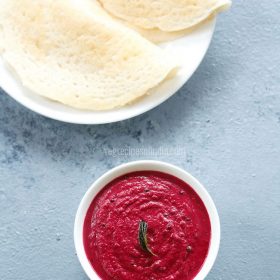This beautiful, vibrant Beetroot Pachadi or Beetroot Chutney is a tasty and healthy chutney variant from the South Indian cuisine of Tamil Nadu and made with beetroots, coconut, lentils, herbs and spices. Make this no onion and no garlic pachadi recipe in 30 minutes and serve as a breakfast dip with Idli, Dosa and Vada.
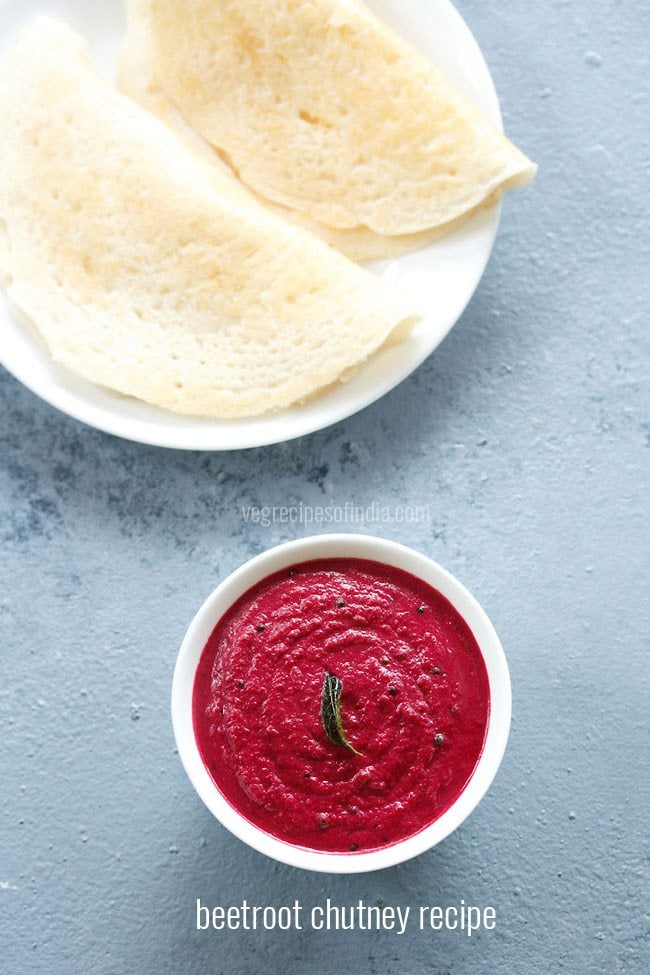
About Beetroot Pachadi Recipe
This Beetroot Chutney is bright and vibrant in color! The reddish-pink hues come from the beetroot and not only does this chutney look good but it tastes delicious too!
This chutney is a South Indian recipe. You won’t get the typical aroma and taste of beetroots from this chutney.
The Beetroot Pachadi has sweet mellow flavors and the green chilies add some heat! The lentils, coconut, and herbs add even more delicious flavor to this chutney making it the perfect breakfast dip!
Making the recipe is simple. Here the beets are cooked first. I usually grate the beets as they cook faster. But you could opt to finely chop them and cook them in some water until tender. When softened blitz all the cooked beets in a high-speed blender or mixer-grinder.
Later you need to bloom some spices (called tempering) and add it to the finely ground chutney. Serve Beetroot Chutney with a breakfast of idli, dosa, uttapam or even as a side with chapati or with rice for your main meals.
If you like beets, you will love this beetroot chutney.
Step-by-Step Guide
How to Make Beetroot Pachadi
Prep and Sauté Beets
1. Rinse, peel and grate 1 large beetroot (150 grams). You will need 1 cup grated beetroot.
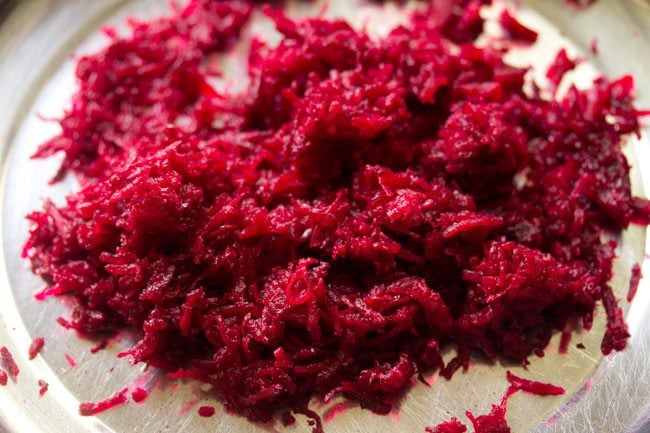
2. Heat a pan and add 1 tablespoon sesame oil (gingelly oil made from raw sesame seeds). Let the oil become hot and then lower the heat. You can opt to use any neutral oil.
Add 1 teaspoon urad dal (split husked black gram) and 1 teaspoon chana dal (split husked bengal gram).
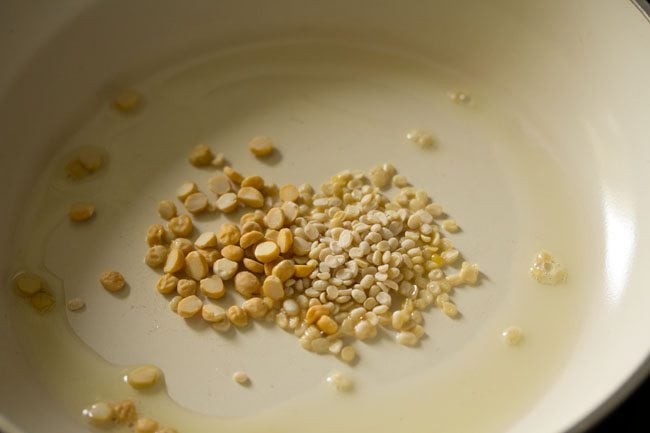
3. Fry and stir often on a low heat.
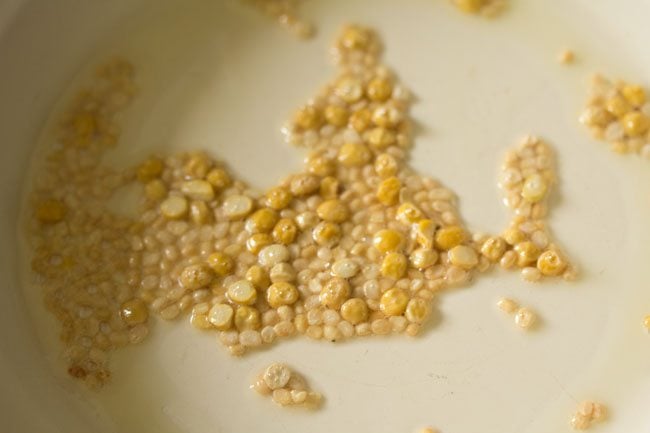
4. Fry until both the lentils become golden. Do not burn them. Remember to fry the lentils until golden. They should not be raw or undercooked.
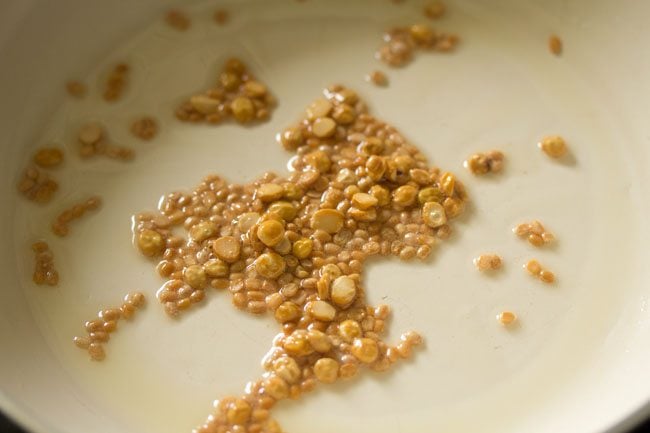
5. Add the grated beetroot. Stir and mix well.
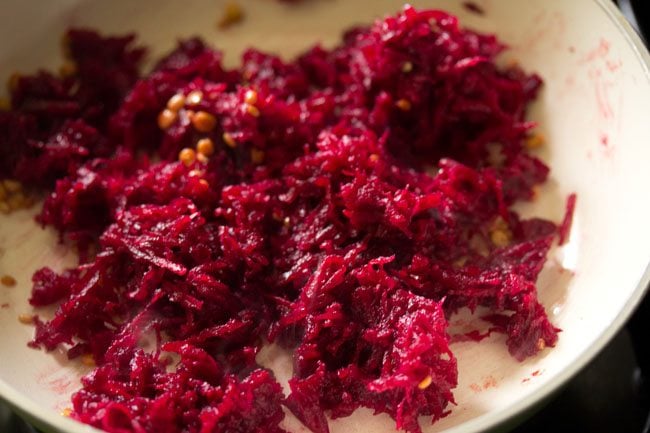
6. Add 1 to 2 chopped green chilies (about ½ to 1 teaspoon chopped), 6 to 7 curry leaves and a generous pinch of asafoetida (hing).
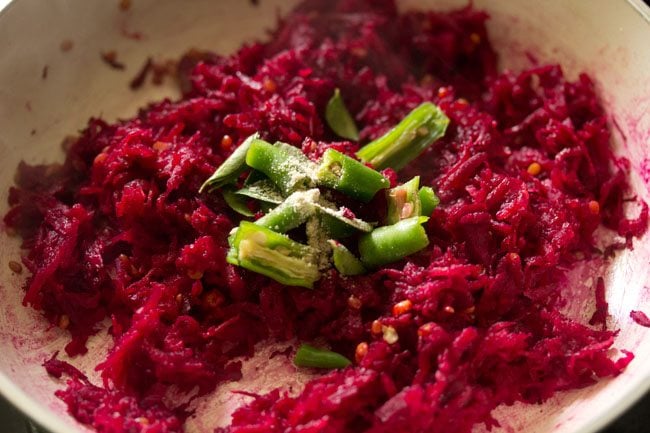
7. Mix well and saute on a low flame until the raw aroma of the beetroot goes away.
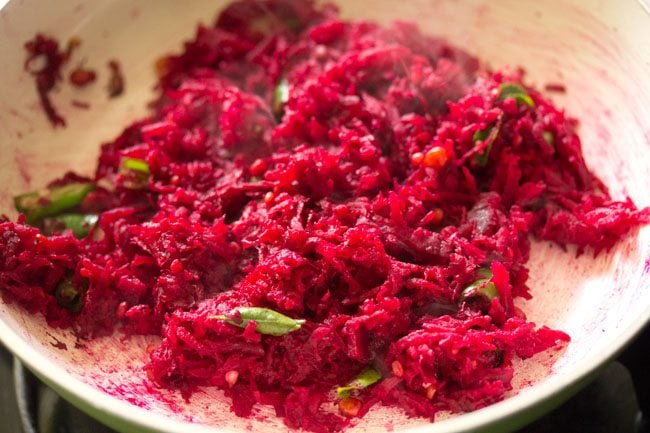
8. Sauté for a total of 5 to 6 minutes on a low heat. Keep on stirring often while sautéing.
If the ingredients start sticking to the pan, add in 1 to 2 tablespoons of water. Deglaze and continue to sauté.
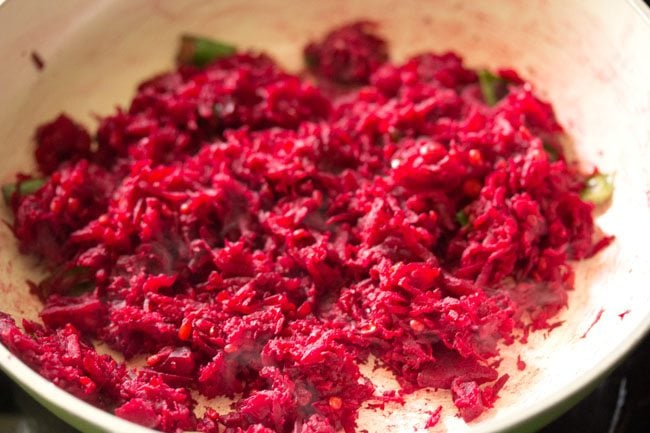
9. Switch off the heat and add ⅓ cup of grated coconut. Mix very well.
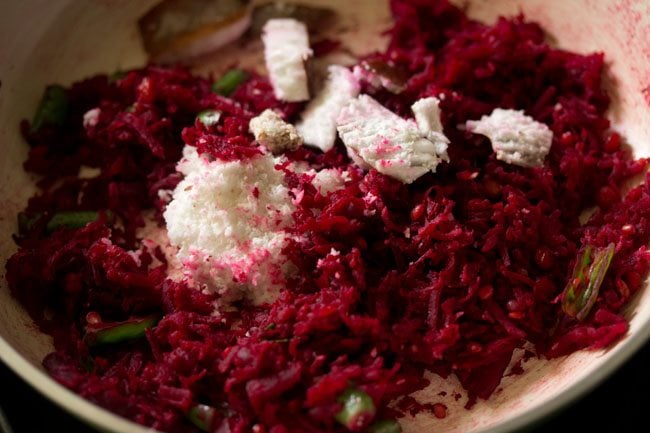
Make Beetroot Chutney
10. When the mixture becomes warm or cools, add in a grinder or blender. Add salt to taste.
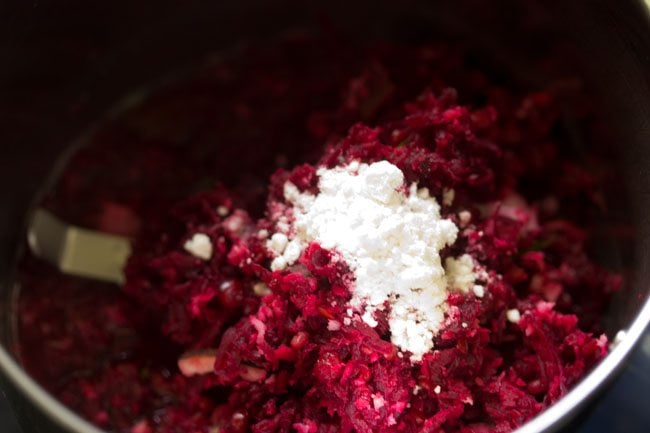
11. Pour ⅓ to ½ cup water and grind to a smooth chutney with a fine consistency.
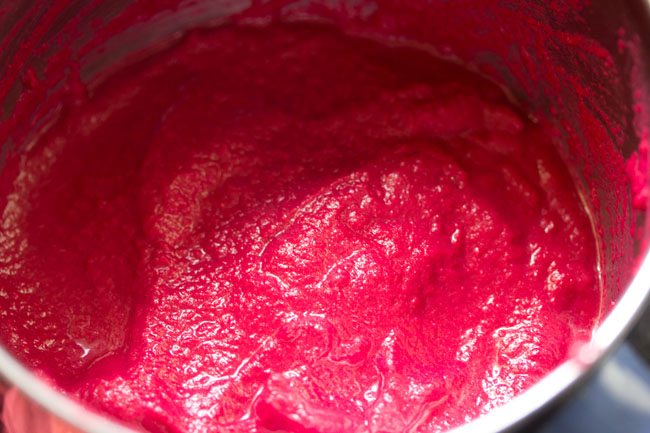
12. Remove all the chutney in a bowl. Set aside.
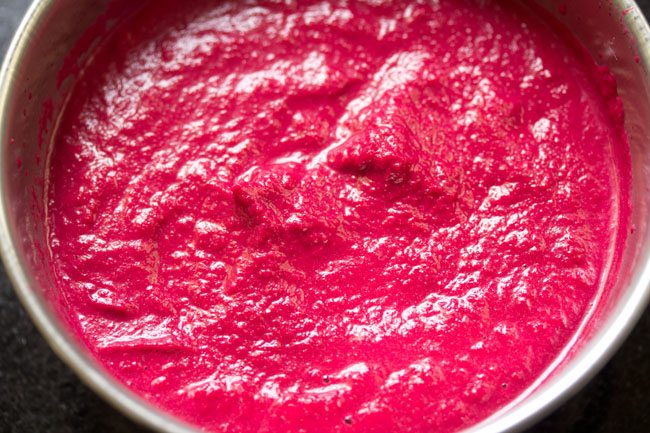
Make Tempering
13. Heat 1 to 2 teaspoons of sesame oil (gingelly oil) in the same pan, in which the beetroots were sautéed or feel free to use another pan. Add ½ teaspoon mustard seeds and let them crackle.
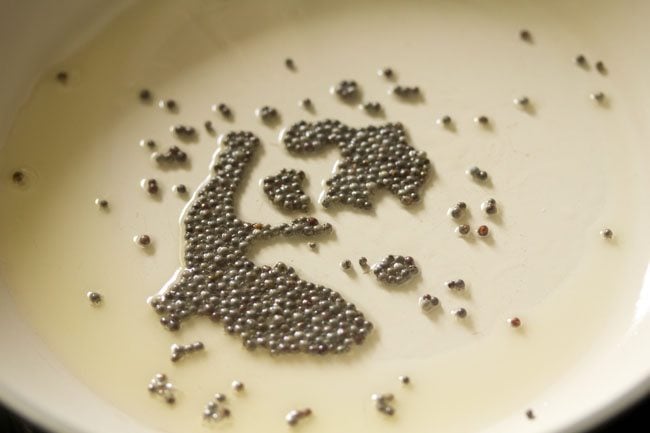
14. Add 6 to 7 curry leaves and a pinch of asafoetida (hing). Mix well and then switch off the heat.
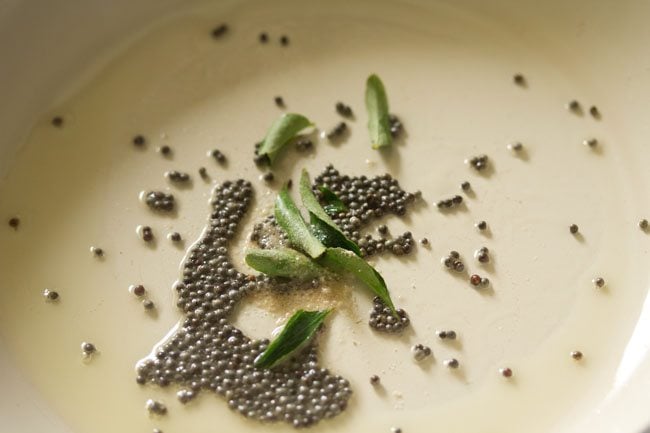
15. Pour the tempering mixture together with the oil in the ground beetroot chutney. Combine and mix very well.
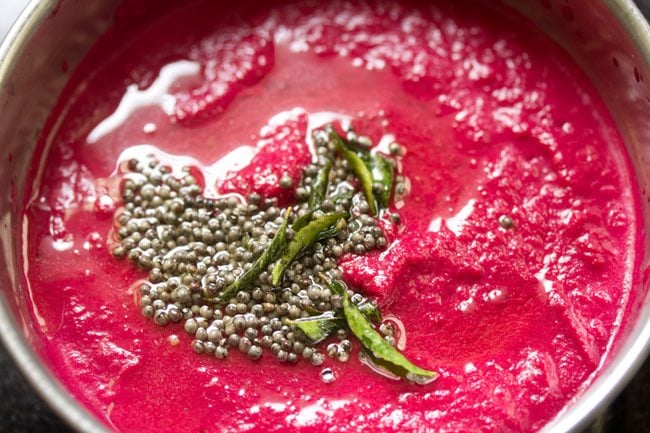
Serving and Storage Suggestions
16. Serve Beetroot Pachadi with any idli or dosa variety. It can be served as a side dish with roti or paratha. I like to serve it with Rava Idli, Rava Dosa, Neer dosa, Adai or Set Dosa.
I also make it as a side chutney condiment with Ven Pongal, khichdi or a simple Sambar and dal served with steamed rice.
I recommend to use up the entire chutney in a day as it has coconut – that gets rancid soon. Store leftover Beetroot Pachadi in the fridge and try to eat it the same day or at the most keep it in the fridge for one day.
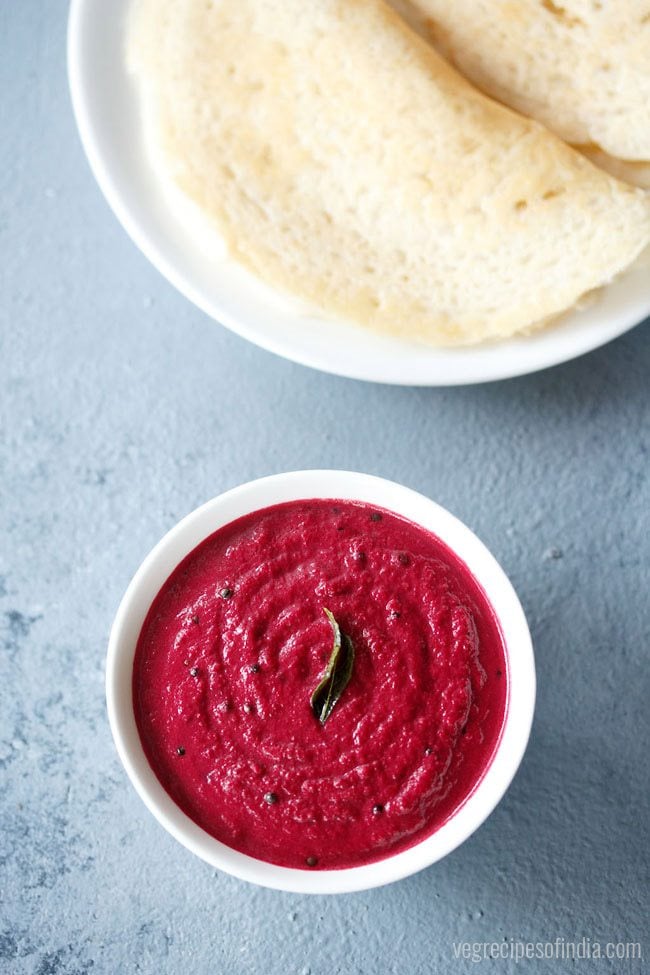
Expert Tips
- Beets: Include beetroots that are fresh, firm, tender and juicy. Beets that are dried or shrunken or have become limp or too softened are best avoided.
- Consistency: Be careful not to thin out the beetroot chutney too much with water, as the flavors will get diluted. If you need to thicken the chutney then add some almond meal, almond flour, or ground roasted peanut powder, or roasted chana dal powder.
- Flavor: Customize this beetroot chutney to your taste! If you want more heat then add more green chilies. If you like the sweetness from the coconut then add more.
- Scaling: You could easily scale this beetroot pachadi and make a big batch for parties or get-togethers!
- Coconut: I have used freshly grated coconut in the recipe. However, you can also use unsweetened desiccated coconut if you do not have fresh coconut.
FAQs
I would not freeze beetroot chutney because it includes coconut. The texture of the coconut in the chutney will change after freezing it and the taste will also be affected.
Beetroot chutney goes well with idli, set dosa, rava dosa, neer dosa, and any other idli or dosa variety. It can also be served as a side dish with roti or paratha.
Chutney can be refrigerated for up to some hours or for about 1 day in an airtight container.
More Delicious Chutney Recipes!
Please be sure to rate the recipe in the recipe card or leave a comment below if you have made it. For more veetarian inspirations, Sign Up for my emails or follow me on Instagram, Youtube, Facebook, Pinterest or Twitter.
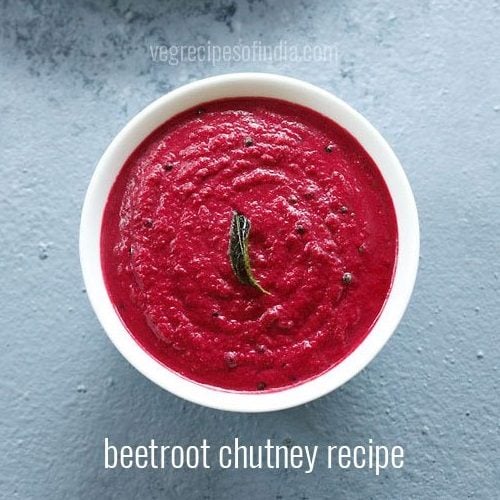
Beetroot Pachadi Recipe (Beetroot Chutney)
Prep Time 7 minutes
Cook Time 8 minutes
Total Time 15 minutes
Prevent your screen from going dark while making the recipe
Sautéing spices, beets
Heat a pan and add 1 tablespoon sesame oil. Let the oil become hot and then lower the flame. Add the urad dal and chana dal.
Fry stirring often on a low heat till both the lentils become golden. Do not burn them.
Then add the grated beetroot. Stir and mix well.
Now add the chopped green chillies, curry leaves and a generous pinch of asafoetida.
Mix well and sauté on a low flame for 5 to 6 minutes or till the raw aroma of the beetroot goes away. Keep on stirring often while sautéing.
Switch off the heat and add the grated fresh coconut. Mix very well.
When the mixture becomes warm, take it in a grinder or blender.
Tempering
Heat 1 to 2 teaspoons sesame oil in the same pan, in which the beetroots were sauteed. Add ½ teaspoon mustard seeds and let them crackle.
Then add the curry leaves and a pinch of asafoetida (hing). Mix well and then switch off the heat.
Pour the tempering mixture in the ground beetroot chutney. Mix very well.
Serving and Storage Suggestions
Serve beetroot chutney with any idli or dosa variety. It can be served as a side dish with roti, chapati or paratha as well. Enjoy it with idli, rava Idli, dosa, rava dosa, neer dosa, adai or set dosa.
This beetroot pachadi pairs nicely as a side chutney condiment with ven pongal, khichdi or a simple sambar or dal served with steamed Rice.
I recommend to use up the entire pachadi in a day as it has coconut. Store leftovers in the fridge and try to eat the pachadi the same day or at the most keep it in the fridge for one day.
- Beets: Make sure to include beetroots that are fresh, firm, tender and juicy. Avoid using beets that are shrunk or have become limp or too softened.
- Consistency: Be careful not to thin out the beetroot chutney too much with water, as the flavors will get diluted. If you need to thicken the chutney then add some almond meal, almond flour, or ground roasted peanut powder or roasted chana dal powder.
- Flavor: Customize this beetroot chutney to your taste! If you want more heat then add more green chilies. If you like the sweetness from the coconut then add more.
- Scaling: You could easily scale this beetroot recipe and make a big batch.
- Coconut: I have used freshly grated coconut in the recipe. But, you can use unsweetened desiccated coconut if you do not have fresh coconut.
Nutrition Facts
Beetroot Pachadi Recipe (Beetroot Chutney)
Amount Per Serving
Calories 138 Calories from Fat 90
% Daily Value*
Fat 10g15%
Saturated Fat 6g38%
Sodium 482mg21%
Potassium 222mg6%
Carbohydrates 11g4%
Fiber 4g17%
Sugar 5g6%
Protein 2g4%
Vitamin A 144IU3%
Vitamin B1 (Thiamine) 1mg67%
Vitamin B2 (Riboflavin) 1mg59%
Vitamin B3 (Niacin) 39mg195%
Vitamin B6 1mg50%
Vitamin C 71mg86%
Vitamin E 1mg7%
Vitamin K 1µg1%
Calcium 35mg4%
Vitamin B9 (Folate) 448µg112%
Iron 1mg6%
Magnesium 24mg6%
Phosphorus 45mg5%
Zinc 1mg7%
* Percent Daily Values are based on a 2000 calorie diet.
This Beetroot Pachadi recipe from the blog archives first published on October 2016 has been updated and republished on May 2023.
Source link


